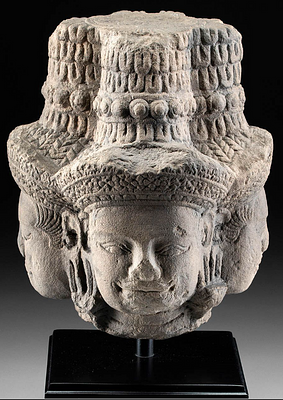Rare Egyptian Limestone Sculptor's Model - Taweret Head
Lot 2a
About Seller
Artemis Fine Arts
686 S Taylor Ave, Ste 106
Louisville, CO 80027
United States
Selling antiquities, ancient and ethnographic art online since 1993, Artemis Gallery specializes in Classical Antiquities (Egyptian, Greek, Roman, Near Eastern), Asian, Pre-Columbian, African / Tribal / Oceanographic art. Our extensive inventory includes pottery, stone, metal, wood, glass and textil...Read more
Categories
Estimate:
$7,000 - $10,500
Absentee vs Live bid
Two ways to bid:
- Leave a max absentee bid and the platform will bid on your behalf up to your maximum bid during the live auction.
- Bid live during the auction and your bids will be submitted real-time to the auctioneer.
Bid Increments
| Price | Bid Increment |
|---|---|
| $0 | $25 |
| $300 | $50 |
| $1,000 | $100 |
| $2,000 | $250 |
| $5,000 | $500 |
| $10,000 | $1,000 |
| $20,000 | $2,500 |
| $50,000 | $5,000 |
| $100,000 | $10,000 |
| $200,000 | $20,000 |
About Auction
By Artemis Fine Arts
Jun 29, 2023
Set Reminder
2023-06-29 10:00:00
2023-06-29 10:00:00
America/New_York
Bidsquare
Bidsquare : Exceptional Antiquities, Ethnographic and Fine Art
https://www.bidsquare.com/auctions/artemis-gallery/exceptional-antiquities-ethnographic-and-fine-art-13031
Artemis Fine Arts info@artemisfinearts.com
Artemis Fine Arts info@artemisfinearts.com
- Lot Description
Ancient Egypt, Ptolemaic Period, ca. 2nd to late 1st century BCE. A fine and rare limestone sculptor's model depicting Taweret, the amalgam goddess of marriage and protector of women, especially those in childbirth. Taweret (also Tawaret, Tauret, or Thoueris) is shown with typical almond-shaped eyes, heavy cosmetic lines around the orbitals, and a strong snout, however the muzzle is more bovine in form than hippopotamus; this is especially noticeable given the stocky chin. A pair of perky ears rest beneath the bases of 2 thick horns, perhaps Hathoric in presentation, and the back of the mandible and head are gently rounded. Size: 7.2" L x 5.3" W x 7.25" H (18.3 cm x 13.5 cm x 18.4 cm); 10.875" H (27.6 cm) on included custom stand.
A carved head like this example may have served as a model for a larger sculpture, to teach apprentice sculptors how to replicate a master style, or to produce ushabti figures (small funerary statues for tombs). Though sculptors' models are typically difficult to date - with some being from the Amarna period of the 18th Dynasty when new forms of statuary came in - most known examples are from the Late Dynastic and Ptolemaic periods. The Egyptians were keen observers of fauna, with many different animals gracing their mythology, artwork, and hieroglyphs; however, anthropomorphic models were typically among the most challenging to carve accurately.
While sculptors' models appear to be from larger composite figures, their incomplete presentation could be an entirely separate item typology. Ancient Greek sculptural incompleteness was a generic form of presentation as the viewer could extrapolate who or what a sculpture was meant to represent. In contrast, the ancient Egyptians would view an incomplete votive work of art only as it was: part of a bird, a disembodied head, or in one instance the hind quarters of a lion. According to Eric Young of the Metropolitan Museum of Art, "When we consider the Egyptian pieces as sculptors' models, however, their incompleteness is no longer disturbing, but entirely understandable. As is the case with unquestioned sculptors' models...the apprentice sculptor concentrated his energies on those portions of the figure that he found intriguing, or most difficult, and the master sculptor demonstrated the correct way to delineate a head…" ("Sculptors' Models or Votives? In Defense of a Scholarly Tradition." The Metropolitan Museum of Art Bulletin, March 1964, p. 255).
Cf. a sculpture of Taweret with very similar facial features at The Fitzwilliam Museum entitled, "Statue of the Goddess Taweret."
Provenance: ex-private Santa Barbara, California, USA collection; ex-Charles Craig collection, before 2000
All items legal to buy/sell under U.S. Statute covering cultural patrimony Code 2600, CHAPTER 14, and are guaranteed to be as described or your money back.
A Certificate of Authenticity will accompany all winning bids.
We ship worldwide and handle all shipping in-house for your convenience.
#179661Professional restoration to nose, with resurfacing and overpainting along new material and break lines. Losses to horns as shown, with possible stabilization to fissure around and beneath mandible. Minor chips and abrasions, with light resurfacing to some areas, and minor earthen deposits, otherwise in excellent condition. Wonderful preservation to unique facial features. Mounting hole drilled and lined with metal along bottom in modern times.Condition
- Shipping Info
-
All shipping is handled in-house for your convenience. Your invoice from Artemis Gallery will include shipping calculation instructions. If in doubt, please inquire BEFORE bidding for estimated shipping costs for individual items.
-
- Buyer's Premium



 EUR
EUR CAD
CAD AUD
AUD GBP
GBP MXN
MXN HKD
HKD CNY
CNY MYR
MYR SEK
SEK SGD
SGD CHF
CHF THB
THB














